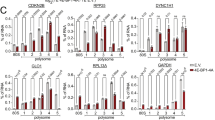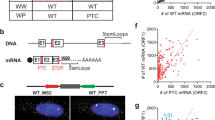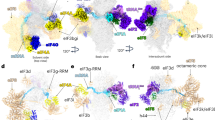Abstract
The nonsense-mediated mRNA decay (NMD) pathway degrades mRNAs undergoing premature termination of translation. It has been argued that in human cells, NMD is restricted to a pioneer round of translation initiated on mRNAs associated with the cap-binding complex (CBC) and that the exchange of the CBC for the eIF4F translation initiation complex renders mRNAs immune to NMD. Here, we demonstrate that human mRNAs undergoing eIF4F-dependent translation are not immune to NMD. First, prolonged translation inhibition does not render an NMD substrate resistant to NMD, despite allowing exchange of CBC for eIF4F. Second, eIF4F inhibitors stabilize NMD substrates undergoing cap-dependent translation. Third, the eIF4E-associated pool of an NMD substrate degrades as rapidly as the overall pool of the mRNA. Thus, eIF4F-dependent translation supports NMD in human cells, allowing for the possibility that NMD could be activated upon cellular cues on already translating mRNAs.
This is a preview of subscription content, access via your institution
Access options
Subscribe to this journal
Receive 12 print issues and online access
$259.00 per year
only $21.58 per issue
Buy this article
- Purchase on SpringerLink
- Instant access to full article PDF
Prices may be subject to local taxes which are calculated during checkout






Similar content being viewed by others
References
Houseley, J. & Tollervey, D. The many pathways of RNA degradation. Cell 136, 763–776 (2009).
Chang, Y.F., Imam, J.S. & Wilkinson, M.F. The nonsense-mediated decay RNA surveillance pathway. Annu. Rev. Biochem. 76, 51–74 (2007).
Mühlemann, O., Eberle, A.B., Stalder, L. & Zamudio Orozco, R. Recognition and elimination of nonsense mRNA. Biochim. Biophys. Acta 1779, 538–549 (2008).
He, F. et al. Genome-wide analysis of mRNAs regulated by the nonsense-mediated and 5′ to 3′ mRNA decay pathways in yeast. Mol. Cell 12, 1439–1452 (2003).
Mendell, J.T., Sharifi, N.A., Meyers, J.L., Martinez-Murillo, F. & Dietz, H.C. Nonsense surveillance regulates expression of diverse classes of mammalian transcripts and mutes genomic noise. Nat. Genet. 36, 1073–1078 (2004).
Rehwinkel, J., Letunic, I., Raes, J., Bork, P. & Izaurralde, E. Nonsense-mediated mRNA decay factors act in concert to regulate common mRNA targets. RNA 11, 1530–1544 (2005).
Kervestin, S. & Jacobson, A. NMD: a multifaceted response to premature translational termination. Nat. Rev. Mol. Cell Biol. 13, 700–712 (2012).
Nicholson, P. et al. Nonsense-mediated mRNA decay in human cells: mechanistic insights, functions beyond quality control and the double-life of NMD factors. Cell Mol. Life Sci. 67, 677–700 (2010).
Rebbapragada, I. & Lykke-Andersen, J. Execution of nonsense-mediated mRNA decay: what defines a substrate? Curr. Opin. Cell Biol. 21, 394–402 (2009).
Le Hir, H., Moore, M.J. & Maquat, L.E. Pre-mRNA splicing alters mRNP composition: evidence for stable association of proteins at exon-exon junctions. Genes Dev. 14, 1098–1108 (2000).
Saulière, J. et al. CLIP-seq of eIF4AIII reveals transcriptome-wide mapping of the human exon junction complex. Nat. Struct. Mol. Biol. 19, 1124–1131 (2012).
Singh, G. et al. The cellular EJC interactome reveals higher-order mRNP structure and an EJC-SR protein nexus. Cell 151, 750–764 (2012).
Kim, V.N., Kataoka, N. & Dreyfuss, G. Role of the nonsense-mediated decay factor hUpf3 in the splicing-dependent exon-exon junction complex. Science 293, 1832–1836 (2001).
Le Hir, H., Gatfield, D., Izaurralde, E. & Moore, M.J. The exon-exon junction complex provides a binding platform for factors involved in mRNA export and nonsense-mediated mRNA decay. EMBO J. 20, 4987–4997 (2001).
Lykke-Andersen, J., Shu, M.D. & Steitz, J.A. Communication of the position of exon-exon junctions to the mRNA surveillance machinery by the protein RNPS1. Science 293, 1836–1839 (2001).
Amrani, N. et al. A faux 3′-UTR promotes aberrant termination and triggers nonsense-mediated mRNA decay. Nature 432, 112–118 (2004).
Behm-Ansmant, I., Gatfield, D., Rehwinkel, J., Hilgers, V. & Izaurralde, E. A conserved role for cytoplasmic poly(A)-binding protein 1 (PABPC1) in nonsense-mediated mRNA decay. EMBO J. 26, 1591–1601 (2007).
Eberle, A.B., Stalder, L., Mathys, H., Orozco, R.Z. & Muhlemann, O. Posttranscriptional gene regulation by spatial rearrangement of the 3′ untranslated region. PLoS Biol. 6, e92 (2008).
Ivanov, P.V., Gehring, N.H., Kunz, J.B., Hentze, M.W. & Kulozik, A.E. Interactions between UPF1, eRFs, PABP and the exon junction complex suggest an integrated model for mammalian NMD pathways. EMBO J. 27, 736–747 (2008).
Silva, A.L., Ribeiro, P., Inacio, A., Liebhaber, S.A. & Romao, L. Proximity of the poly(A)-binding protein to a premature termination codon inhibits mammalian nonsense-mediated mRNA decay. RNA 14, 563–576 (2008).
Singh, G., Rebbapragada, I. & Lykke-Andersen, J. A competition between stimulators and antagonists of Upf complex recruitment governs human nonsense-mediated mRNA decay. PLoS Biol. 6, e111 (2008).
Yamashita, A., Ohnishi, T., Kashima, I., Taya, Y. & Ohno, S. Human SMG-1, a novel phosphatidylinositol-3-kinase-related protein kinase, associates with components of the mRNA surveillance complex and is involved in the regulation of nonsense-mediated mRNA decay. Genes Dev. 15, 2215–2228 (2001).
Cho, H., Kim, K.M. & Kim, Y.K. Human proline-rich nuclear receptor coregulatory protein 2 mediates an interaction between mRNA surveillance machinery and decapping complex. Mol. Cell 33, 75–86 (2009).
Eberle, A.B., Lykke-Andersen, S., Muhlemann, O. & Jensen, T.H. SMG6 promotes endonucleolytic cleavage of nonsense mRNA in human cells. Nat. Struct. Mol. Biol. 16, 49–55 (2009).
Huntzinger, E., Kashima, I., Fauser, M., Sauliere, J. & Izaurralde, E. SMG6 is the catalytic endonuclease that cleaves mRNAs containing nonsense codons in metazoan. RNA 14, 2609–2617 (2008).
Unterholzner, L. & Izaurralde, E. SMG7 acts as a molecular link between mRNA surveillance and mRNA decay. Mol. Cell 16, 587–596 (2004).
Franks, T.M., Singh, G. & Lykke-Andersen, J. Upf1 ATPase-dependent mRNP disassembly is required for completion of nonsense-mediated mRNA decay. Cell 143, 938–950 (2010).
Chiu, S.Y., Serin, G., Ohara, O. & Maquat, L.E. Characterization of human Smg5/7a: a protein with similarities to Caenorhabditis elegans SMG5 and SMG7 that functions in the dephosphorylation of Upf1. RNA 9, 77–87 (2003).
Ohnishi, T. et al. Phosphorylation of hUPF1 induces formation of mRNA surveillance complexes containing hSMG-5 and hSMG-7. Mol. Cell 12, 1187–1200 (2003).
Chiu, S.Y., Lejeune, F., Ranganathan, A.C. & Maquat, L.E. The pioneer translation initiation complex is functionally distinct from but structurally overlaps with the steady-state translation initiation complex. Genes Dev. 18, 745–754 (2004).
Ishigaki, Y., Li, X., Serin, G. & Maquat, L.E. Evidence for a pioneer round of mRNA translation: mRNAs subject to nonsense-mediated decay in mammalian cells are bound by CBP80 and CBP20. Cell 106, 607–617 (2001).
Görlich, D. et al. Importin provides a link between nuclear protein import and U snRNA export. Cell 87, 21–32 (1996).
Sato, H. & Maquat, L.E. Remodeling of the pioneer translation initiation complex involves translation and the karyopherin importin-β. Genes Dev. 23, 2537–2550 (2009).
Sonenberg, N. & Dever, T.E. Eukaryotic translation initiation factors and regulators. Curr. Opin. Struct. Biol. 13, 56–63 (2003).
Fortes, P. et al. The yeast nuclear cap binding complex can interact with translation factor eIF4G and mediate translation initiation. Mol. Cell 6, 191–196 (2000).
Kim, K.M. et al. A new MIF4G domain-containing protein, CTIF, directs nuclear cap-binding protein CBP80/20-dependent translation. Genes Dev. 23, 2033–2045 (2009).
Hosoda, N., Kim, Y.K., Lejeune, F. & Maquat, L.E. CBP80 promotes interaction of Upf1 with Upf2 during nonsense-mediated mRNA decay in mammalian cells. Nat. Struct. Mol. Biol. 12, 893–901 (2005).
Lejeune, F., Ishigaki, Y., Li, X. & Maquat, L.E. The exon junction complex is detected on CBP80-bound but not eIF4E-bound mRNA in mammalian cells: dynamics of mRNP remodeling. EMBO J. 21, 3536–3545 (2002).
Lejeune, F., Ranganathan, A.C. & Maquat, L.E. eIF4G is required for the pioneer round of translation in mammalian cells. Nat. Struct. Mol. Biol. 11, 992–1000 (2004).
Dzikiewicz-Krawczyk, A., Piontek, P., Szweykowska-Kulinska, Z. & Jarmolowski, A. The nuclear cap-binding protein complex is not essential for nonsense-mediated mRNA decay (NMD) in plants. Acta Biochim. Pol. 55, 825–828 (2008).
Gao, Q., Das, B., Sherman, F. & Maquat, L.E. Cap-binding protein 1-mediated and eukaryotic translation initiation factor 4E-mediated pioneer rounds of translation in yeast. Proc. Natl. Acad. Sci. USA 102, 4258–4263 (2005).
Kuperwasser, N., Brogna, S., Dower, K. & Rosbash, M. Nonsense-mediated decay does not occur within the yeast nucleus. RNA 10, 1907–1915 (2004).
Keeling, K.M. et al. Leaky termination at premature stop codons antagonizes nonsense-mediated mRNA decay in S. cerevisiae. RNA 10, 691–703 (2004).
Maderazo, A.B., Belk, J.P., He, F. & Jacobson, A. Nonsense-containing mRNAs that accumulate in the absence of a functional nonsense-mediated mRNA decay pathway are destabilized rapidly upon its restitution. Mol. Cell Biol. 23, 842–851 (2003).
Maquat, L.E., Hwang, J., Sato, H. & Tang, Y. CBP80-promoted mRNP rearrangements during the pioneer round of translation, nonsense-mediated mRNA decay, and thereafter. Cold Spring Harb. Symp. Quant. Biol. 75, 127–134 (2010).
Pestka, S. Inhibitors of ribosome functions. Annu. Rev. Microbiol. 25, 487–562 (1971).
Yamashita, A. et al. Concerted action of poly(A) nucleases and decapping enzyme in mammalian mRNA turnover. Nat. Struct. Mol. Biol. 12, 1054–1063 (2005).
Moerke, N.J. et al. Small-molecule inhibition of the interaction between the translation initiation factors eIF4E and eIF4G. Cell 128, 257–267 (2007).
Holbrook, J.A., Neu-Yilik, G., Gehring, N.H., Kulozik, A.E. & Hentze, M.W. Internal ribosome entry sequence-mediated translation initiation triggers nonsense-mediated decay. EMBO Rep. 7, 722–726 (2006).
Woeller, C.F., Gaspari, M., Isken, O. & Maquat, L.E. NMD resulting from encephalomyocarditis virus IRES-directed translation initiation seems to be restricted to CBP80/20-bound mRNA. EMBO Rep. 9, 446–451 (2008).
Gingras, A.C., Raught, B. & Sonenberg, N. Regulation of translation initiation by FRAP/mTOR. Genes Dev. 15, 807–826 (2001).
Gingras, A.C. et al. Regulation of 4E–BP1 phosphorylation: a novel two-step mechanism. Genes Dev. 13, 1422–1437 (1999).
Moriarty, P.M., Reddy, C.C. & Maquat, L.E. Selenium deficiency reduces the abundance of mRNA for Se-dependent glutathione peroxidase 1 by a UGA-dependent mechanism likely to be nonsense codon-mediated decay of cytoplasmic mRNA. Mol. Cell Biol. 18, 2932–2939 (1998).
Hogg, J.R. & Goff, S.P. Upf1 senses 3′ UTR length to potentiate mRNA decay. Cell 143, 379–389 (2010).
Gehring, N.H., Lamprinaki, S., Kulozik, A.E. & Hentze, M.W. Disassembly of exon junction complexes by PYM. Cell 137, 536–548 (2009).
Dostie, J. & Dreyfuss, G. Translation is required to remove Y14 from mRNAs in the cytoplasm. Curr. Biol. 12, 1060–1067 (2002).
Huang, L. et al. RNA homeostasis governed by cell type-specific and branched feedback loops acting on NMD. Mol. Cell 43, 950–961 (2011).
Yepiskoposyan, H., Aeschimann, F., Nilsson, D., Okoniewski, M. & Muhlemann, O. Autoregulation of the nonsense-mediated mRNA decay pathway in human cells. RNA 17, 2108–2118 (2011).
Giorgi, C. et al. The EJC factor eIF4AIII modulates synaptic strength and neuronal protein expression. Cell 130, 179–191 (2007).
Duke, G.M., Hoffman, M.A. & Palmenberg, A.C. Sequence and structural elements that contribute to efficient encephalomyocarditis virus RNA translation. J. Virol. 66, 1602–1609 (1992).
Lykke-Andersen, J., Shu, M.D. & Steitz, J.A. Human Upf proteins target an mRNA for nonsense-mediated decay when bound downstream of a termination codon. Cell 103, 1121–1131 (2000).
Acknowledgements
We thank P. Sarnow (Stanford University; pGL3-FLuc-IRES-Rluc), G. Wagner (Harvard Medical School; 4EGI-1) and E. Izaurralde (Max Planck Institute for Developmental Biology; antibody to CBP80) for valuable reagents. We thank R. Lardelli for critical comments on the manuscript and members of J.L.-A.'s laboratory for helpful discussions. This work was supported by a grant from the US National Science Foundation (MCB-0946464) to J.L.-A. and a postdoctoral fellowship from the Fondation pour la Recherche Médicale en France to S.D.
Author information
Authors and Affiliations
Contributions
S.D. and J.L.-A. conceived of and designed the study. S.D. performed the experiments. Both authors analyzed the data and wrote the paper.
Corresponding author
Ethics declarations
Competing interests
The authors declare no competing financial interests.
Supplementary information
Supplementary Text and Figures
Supplementary Figures 1–5 (PDF 6633 kb)
Rights and permissions
About this article
Cite this article
Durand, S., Lykke-Andersen, J. Nonsense-mediated mRNA decay occurs during eIF4F-dependent translation in human cells. Nat Struct Mol Biol 20, 702–709 (2013). https://doi.org/10.1038/nsmb.2575
Received:
Accepted:
Published:
Issue date:
DOI: https://doi.org/10.1038/nsmb.2575
This article is cited by
-
FMRP-mediated spatial regulation of physiologic NMD targets in neuronal cells
Genome Biology (2024)
-
Nanopore sequencing reveals endogenous NMD-targeted isoforms in human cells
Genome Biology (2021)
-
Human NMD ensues independently of stable ribosome stalling
Nature Communications (2020)
-
Quality and quantity control of gene expression by nonsense-mediated mRNA decay
Nature Reviews Molecular Cell Biology (2019)
-
Nonsense-mediated RNA decay in the brain: emerging modulator of neural development and disease
Nature Reviews Neuroscience (2018)



